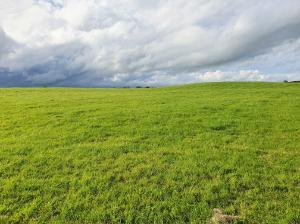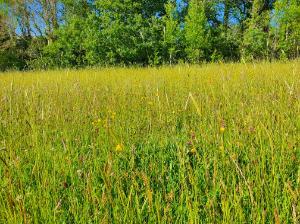A CSO Frontier Series Output - What is this?
This CSO Frontier Publication is part of a series of thematic publications from the CSO on Ecosystem Accounts. It provides preliminary ecosystem accounts for Irish grasslands and croplands. We present data on spatial extent and aspects of condition. These accounts are provisional. More detailed ecosystem accounts on Irish grasslands and croplands, including data on ecosystem services, will be compiled in future editions of this publication, pending data availability and methodological developments.
Ecosystem accounting is a way to account for the contribution of nature to human well-being, by tracking changes in ecosystems and measuring the contribution of ecosystem services to the economy and society. By using an accounting framework, the stock of ecosystems (ecosystem assets) and flows from ecosystems (ecosystem services) can be defined in relation to each other and to a range of other environmental, economic and social information.
Ecosystem assets are spatial areas containing a specific ecosystem type, such as a forest or a peatland. Each ecosystem asset generates a bundle of ecosystem services, such as timber provision or carbon storage, which in turn, generate benefits to human well-being.
These definitions are based on the UN System of Environmental-Economic Accounting - Ecosystem Accounting1 (SEEA-EA) and are explained further in the Information Note on Ecosystem Accounting.
While the SEEA-EA was adopted in 2021, methodologies for ecosystem accounting continue to be refined. Work has been carried out on a range of ecosystems at international, European, and national levels. In Ireland, research has taken place on agricultural ecosystems at river catchment level2, and an ongoing project is developing ecosystem accounts for selected river catchments (see the INCASE project). This frontier publication sets out the initial work carried out by the CSO in developing national ecosystem accounts for grasslands and croplands. In this publication we address extent and condition. Future work will examine ecosystem services.
1. Extent
Ecosystem extent accounts provide information on the type, range and extent of ecosystem assets, i.e. grasslands and croplands. Spatial data on grasslands and croplands in Ireland have been collected by a number of organisations for a variety of purposes, at a range of different spatial scales, and over different time periods. Compiling these data to produce a consistent map at a national level is not straightforward. In the absence of a national ecosystem map, CORINE Land Cover data were used to produce a map of grasslands and croplands for Ireland. This map is comparable with other publications (see Peatlands and Heathlands 2018) and other EU countries. The data can also show changes in extent over time. We also use additional national level data sources to examine grasslands and croplands in more detail.
2. Condition
Ecosystem condition relates to the quality of the ecosystem assets described in the extent accounts. Condition in the SEEA-EA is defined as ‘the quality of an ecosystem measured in terms of its abiotic and biotic characteristics’, i.e. the living (biotic) and non-living (abiotic) components of the ecosystem. We provide data on condition in the form of preliminary condition accounts at a national level to give an indication of the overall condition of grasslands and croplands. To examine the spatial variation in condition, selected data are shown at a river catchment level.
3. Services
While this Frontier Publication will focus only on extent and condition of grasslands and croplands, future work will include ecosystem services. Ecosystem services are defined, in the SEEA-EA, as the contribution of ecosystems to the generation of benefits (i.e. final outputs of an ecosystem) used by the economy and society. The aim of ecosystem services accounts is to provide a coherent and integrated view of the contributions made by ecosystems to the economy and human well-being.
Final ecosystem services are reported under three different headings:
Grasslands and croplands are the ecosystems where the majority of Ireland’s agricultural activity takes place, and they are important economically, environmentally, and socially. This Frontier Publication will focus on examining where grasslands and croplands occur in Ireland, what types of grasslands and croplands they are, and look at some indicators for ecosystem condition.
As well as grasslands and croplands, there are other landscape features associated with agricultural land use, such as hedgerows, that can be described as ‘semi-natural features’ and are also important components of these ecosystems.
Grasslands are the most prevalent land cover type in Ireland and can be defined as areas covered by grass-dominated vegetation or where the vegetation is ‘grassy’ in appearance due to the presence of sedges or rushes. It is important to note that most grasslands in Ireland have been modified through grazing, mowing, drainage, or the application of fertilisers. Without these management practices, many of our grasslands would become scrub, woodland, or heath3. Based on the Heritage Council Classification (Fossitt, 2000)3, Irish grasslands are divided into two main categories, Improved grassland and Semi-natural grassland (see Table 1.1).
Table 1.1 Heritage Council Classification main grassland categories | |||
|---|---|---|---|
| Grassland type | Description | ||
| Improved grasslands |  Photo credit: Maria Long Location: Midlands |
This type of grassland is managed to maximise yield. This management can be considered ‘intensive’, and management practices include reseeding, fertiliser application, and grazing or mowing3. There is usually low diversity of plant species, as fertiliser application selects for a restricted number of species, and reseeding uses a limited range of species. Amenity grasslands (improved, species-poor grasslands managed for purposes other than grass production3, e.g. playing fields) can also be considered Improved grasslands, but will be considered as part of a future publication on Urban ecosystems. | |
| Semi-natural grasslands |  Photo credit: Maria Long Location: Wexford |
These grasslands are extensively managed, i.e. with limited interventions in comparison to intensively managed grasslands. Management practices are less intense, reliance on chemical inputs is less, with the main actions usually limited to grazing or mowing. Semi-natural grasslands are more species-rich than Improved grasslands. Depending on the conditions (soil, management regime, etc.) different grasslands can have different groups of species3, for example acid grasslands or calcareous, wet grasslands or dry. Some semi-natural grasslands are of conservation importance due to the biodiversity (plants and animals) they support. | |
Croplands in the Heritage Council Classification include Arable crops, Horticultural land, and Tilled land3. Croplands can include land managed at a range of intensities, including areas under lower intensity management that can support semi-natural vegetation along with food production. Some areas of cropland can have significant coverage of natural vegetation (agricultural mosaics)4.
Grasslands and croplands form part of the landscape in which we live, but they are not homogeneous. Houses, farmyards, roads, and other components of the built environment occur throughout these ecosystems, as well as a range of semi-natural features, such as field margins, hedgerows, and patches of uncultivated land5,6. These semi-natural features are an important part of grassland and cropland ecosystems with potentially great ecological value, including as habitats and food sources for pollinators and birds, and they can provide intermediate ecosystem services such as pest control and pollination7.
Grasslands and croplands, and associated semi-natural features, provide a range of ecosystem services, including:
Ecosystem services can also impact negatively on human well-being: these are referred to as ecosystem disservices. Disservices that relate to grasslands and croplands can include increased likelihood of flooding (due to drainage networks or land use change), potential for nutrient run-off to water, and negative impacts on climate regulation where carbon is lost to the atmosphere e.g. through agricultural usage of drained peat soils. As with ecosystem services, ecosystem condition can also affect disservices, e.g. grasslands in good condition are less likely to be associated with run-off.
1. System of Environmental Economic Accounting - Ecosystem Accounting. (United Nations, 2021).
2. Norton, D., Hynes, S., Buckley, C., Ryan, M. & Doherty, E. An initial catchment level assessment of the value of Ireland’s agroecosystem services. Biology and Environment: Proceedings of the Royal Irish Academy 120B (2020).
3. Fossitt, J. A. A Guide to Habitats in Ireland. (Heritage Council, 2000).
4. Maes, J. et al. Mapping and Assessment of Ecosystems and their Services: An analytical framework for mapping and assessment of ecosystem condition in EU. (2018).
5. Larkin, J., Sheridan, H., Finn, J. A., Denniston, H. & Ó hUallacháin, D. Semi-natural habitats and Ecological Focus Areas on cereal, beef and dairy farms in Ireland. Land Use Policy 88 (2019).
6. Rotchés-Ribalta, R. et al. Assessment of semi-natural habitats and landscape features on Irish farmland: New insights to inform EU Common Agricultural Policy implementation. Ambio 50 (2021).
7. Garratt, M. P. D., Senapathi, D., Coston, D. J., Mortimer, S. R. & Potts, S. G. The benefits of hedgerows for pollinators and natural enemies depends on hedge quality and landscape context. Agriculture, Ecosystems & Environment 247 (2017).
Go to the next chapter: Extent
Learn about our data and confidentiality safeguards, and the steps we take to produce statistics that can be trusted by all.